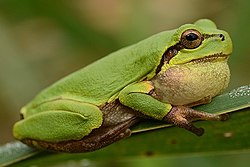Biology:Dryophytes suweonensis
| Suweon treefrog | |
|---|---|

| |
| Scientific classification | |
| Domain: | Eukaryota |
| Kingdom: | Animalia |
| Phylum: | Chordata |
| Class: | Amphibia |
| Order: | Anura |
| Family: | Hylidae |
| Genus: | Dryophytes |
| Species: | D. suweonensis
|
| Binomial name | |
| Dryophytes suweonensis (Kuramoto, 1980)
| |
| Synonyms | |
| |
Dryophytes suweonensis, the Suweon treefrog or Suwon treefrog, is a species of frog in the family Hylidae endemic to the Korean Peninsula[2][3] probably from the Imjin River to the Mangyeong River,[4] south of Iksan.[5] Its distribution and population have been assessed to be below 800 individuals and the status of the species has been updated as Endangered by the IUCN.[1] The natural habitat of the species has been generally transformed into rice fields and it is threatened by habitat loss.
The population size of the species has very strongly declined in population size, similarly to the sister species Dryophytes immaculatus and Dryophytes flaviventris.[6]
The Suweon tree frog and the Japanese tree frog, which is also found in the same region, are the only two hylid species found on the Korean Peninsula. Factors distinguishing them include the frequency of the call,[7] calling behavior,[8] webbing between the toes and the angle of the line between eyes and nostrils.[9] The type locality for the Suweon tree frog is a rice paddy near the Office of Rural Development in Suwon. It has a lifestyle similar to the Japanese tree frog, breeding in rice paddies.[10] The species is not known to breed at any natural site, and microhabitat segregation differentiate them from the Japanese tree frog.[11] The species is evolutionary significant due to its unusual ZW karyotype.[12]
The Suweon tree frog is listed as an "Endangered category I species" in Korea on basis of its limited distribution range and small population size.[13] Besides, it is known to display high prevalence of Chytrid Fungus.[14] However, this frog has also been listed as an invasive species in the United States.[15]
See also
- List of amphibians of Korea
References
- ↑ 1.0 1.1 IUCN SSC Amphibian Specialist Group. (2017). "Dryophytes suweonensis". IUCN Red List of Threatened Species 2017: e.T55670A112715252. doi:10.2305/IUCN.UK.2017-1.RLTS.T55670A112715252.en. https://www.iucnredlist.org/species/55670/112715252. Retrieved 22 September 2022.
- ↑ Dufresnes, Christophe; Litvinchuk, Spartak N.; Borzée, Amaël; Jang, Yikweon; Li, Jia-Tang; Miura, Ikuo; Perrin, Nicolas; Stöck, Matthias (December 2016). "Phylogeography reveals an ancient cryptic radiation in East-Asian tree frogs (Hyla japonica group) and complex relationships between continental and island lineages". BMC Evolutionary Biology 16 (1): 253. doi:10.1186/s12862-016-0814-x. PMID 27884104.
- ↑ Frost, Darrel R. (2022). "Dryophytes suweonensis Kuramoto, 1980". Amphibian Species of the World: An Online Reference. Version 6.1. American Museum of Natural History. http://research.amnh.org/vz/herpetology/amphibia/Amphibia/Anura/Hylidae/Hylinae/Dryophytes/Dryophytes-suweonensis. Retrieved 21 September 2022.
- ↑ Borzée, Amaël; Kim, Kyungmin; Heo, Kyongman; Jablonski, Piotr; Jang, Yikweon (4 October 2017). "Impact of land reclamation and agricultural water regime on the distribution and conservation status of the endangered Dryophytes suweonensis". PeerJ 5 (e3872): e3872. doi:10.7717/peerj.3872. PMID 29018610.
- ↑ Borzée A., Yu SH. & Jang Y. (2016). Dryophytes suweonensis (Suweon Treefrog). Herpetological Review - Geographic Distribution Notes. 47, 3:418.
- ↑ Borzée, A; Messenger, K; Chae, S; Andersen, D; Groffen, J; Kim, Y; An, J; Othman, S et al. (2020). "Yellow sea mediated segregation between North East Asian Dryophytes species". PLOS ONE 15 (6): e0234299. doi:10.1371/journal.pone.0234299. PMID 32579561. Bibcode: 2020PLoSO..1534299B.
- ↑ Jang, Y., Hahm, E. H., Lee, H. J., Park, S., Won, Y. J., & Choe, J. C. (2011). Geographic variation in advertisement calls in a tree frog species: gene flow and selection hypotheses. PLoS One, 6(8), e23297.
- ↑ Borzée, Amaël; Kim, Jun Young; Jang, Yikweon (September 2016). "Asymmetric competition over calling sites in two closely related treefrog species". Scientific Reports 6 (1): 32569. doi:10.1038/srep32569. PMID 27599461. Bibcode: 2016NatSR...632569B.
- ↑ Borzée A., Park S., Kim A., Kim HT., & Jang Y. (2013). Morphometrics of two sympatric species of tree frogs in Korea: a morphological key for the critically endangered Hyla suweonensis in relation to H. japonica. Animal Cells and Systems, 17(5), 348-356.
- ↑ Kuramoto, Mitsuru (1980). "Mating calls of treefrogs (genus Hyla) in the Far East, with description of a new species from Korea". Copeia 1980 (1): 100–108. doi:10.2307/1444138.
- ↑ Borzée A., Kim JY., da Cunha M.A.M., Lee D., Sin E., Oh S., Yi Y. & Jang Y. (2016). Temporal and spatial differentiation in microhabitat use: Implications for reproductive isolation and ecological niche specification. Integrative Zoology. 11, 5:375-387.
- ↑ Dufresnes C., Borzée A., Horn A., Stöck M., Ostini M., … & Perrin N. (2015) Sex-chromosome homomorphy in Palearctic tree frogs results from both turnovers and X-Y recombination. Molecular Biology & Evolution, msv113.
- ↑ Park, Daesik; Kaplan, Robert H. (2013). "Korea regional update". FrogLog 21 (4): 34–35. http://www.amphibians.org/froglog/fl108.
- ↑ Borzée, Amaël; Kosch, Tiffany; Kim, Miyeon; Jang, Yikweon (31 May 2017). "Introduced bullfrogs are associated with increased Batrachochytrium dendrobatidis prevalence and reduced occurrence of Korean treefrogs". PLOS ONE 12 (5): e0177860. doi:10.1371/journal.pone.0177860. PMID 28562628. Bibcode: 2017PLoSO..1277860B.
- ↑ "Amphibians - Frogs/Toads" Washington Department of Fish and Wildlife. Retrieved 22 August 2013.
Wikidata ☰ Q3060896 entry
 |


